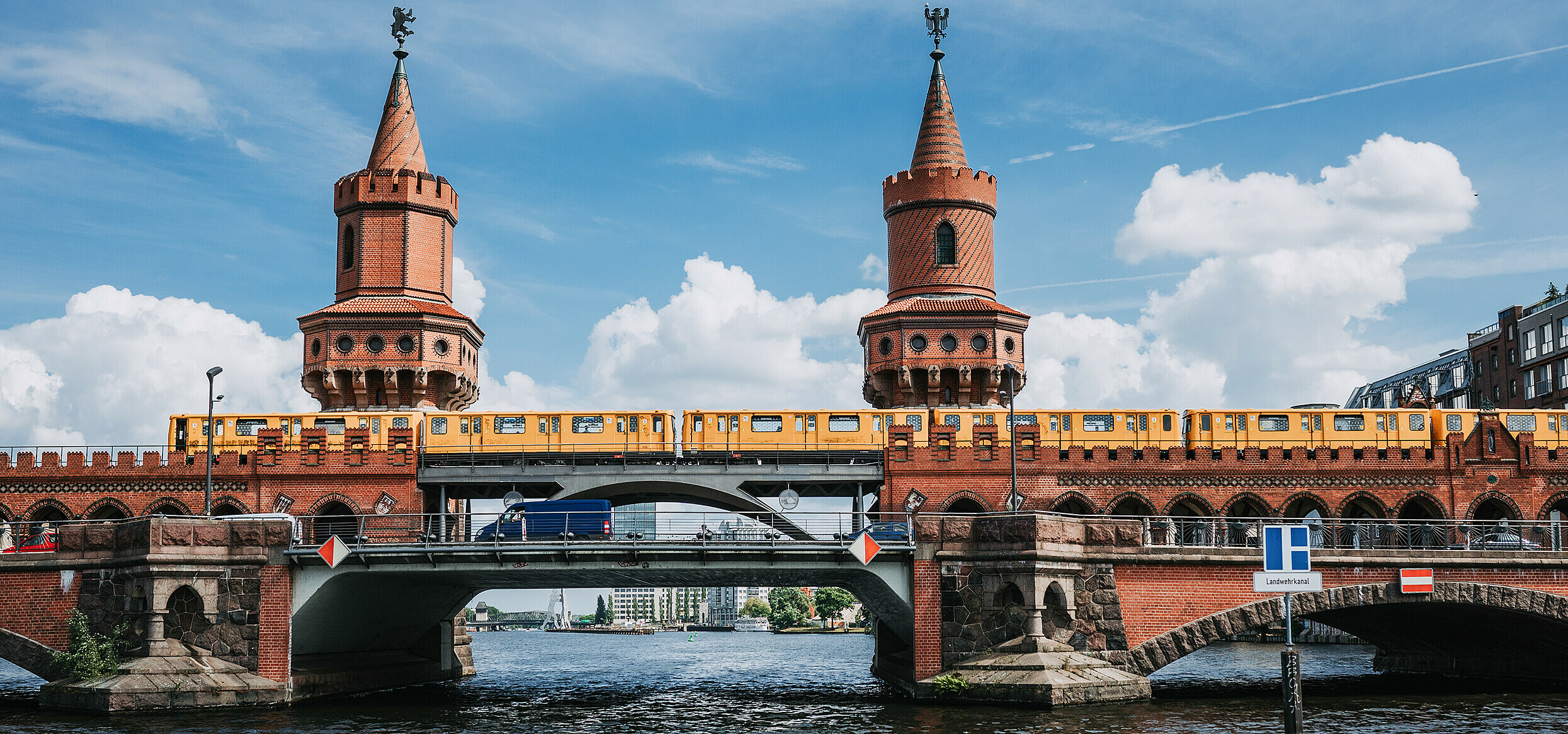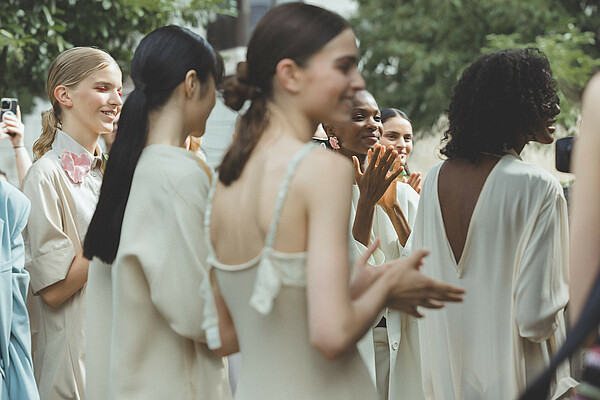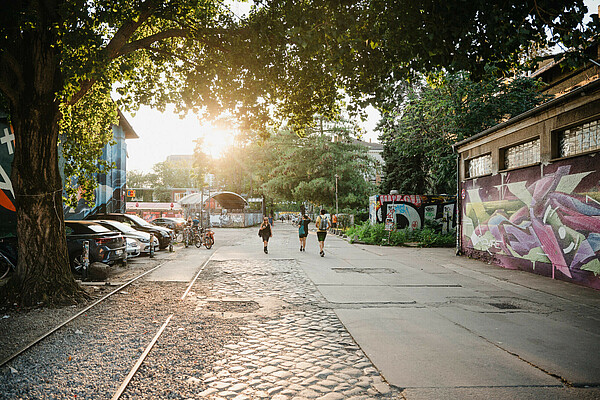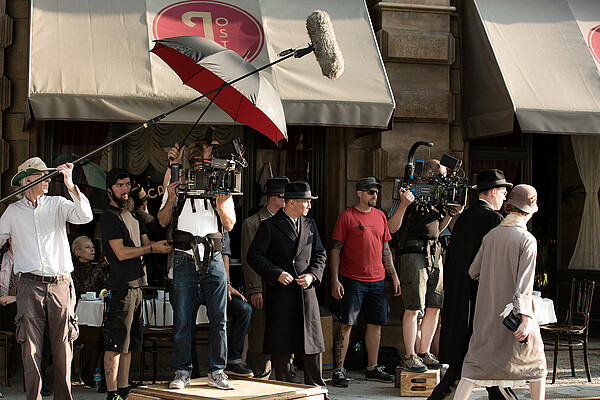Where The Bear Rages
Friedrichshain-Kreuzberg, home of the “Kiezes”.
Berlin is full of “Kieze”, local neighborhoods. No borough has a greater variety of Kieze than Friedrichshain-Kreuzberg.
One reason for this is that the borough is relatively new. It was formed in 2001 by converging the former East Berlin borough of Friedrichshain with the West Berlin borough of Kreuzberg. Between them lies the river Spree, and the historic Oberbaum Bridge has turned into one of Berlin’s landmarks.
Here’s a brief fact sheet on business development in the borough Friedrichshain-Kreuzberg.
Friedrichshain-Kreuzberg is central and at night full of party-goers. As the Germans say, this is where the bear rages, meaning the area is a hive of activity. Flats or office spaces here are highly sought after.
Friedrichshain
The greater transformation within the two districts has undoubtedly taken place in Friedrichshain. In the 90s, after the fall of the wall, the first trendy area to be discovered by artists and newly arriving young people such as students was Prenzlauer Berg. This area was quickly gentrified when many young families moved in, which meant the artists and students migrated to neighboring Friedrichshain.
By now, Friedrichshain is one of the most lively areas in Berlin. The central axis of cool is Boxhagener Strasse, and in the surrounding blocks you’ll find countless bars, cafés, restaurants, and independent shops. Stroll through this pleasant part of town and delight at what you find, be it fetish clothing stores or a center for fingerboarding.
The famously graffitied remainder of the Berlin Wall, the East Side Gallery, is in Friedrichshain. Not far away is the R.A.W., a former industrial site that has now been turned into a huge cultural area for concerts, restaurants, bars, clubs, and events. There is a skate hall, gallery, and flea market on Sundays. This haven for artists and artisans just off the Revaler Strasse is still keeping alive some of the flair that has given Berlin its mystique over the decades.
Kreuzberg
On the other side of the river, Kreuzberg is itself divided into two distinct parts, still known today by their historical postcodes: 36 and 61. The former is more alternative while the latter is more residential.
The spine of 36 is Oranienstrasse, which has a number of eateries and shops where you can get anything from comic books to western cowboy boots. The epicenter of the area is the very urban and architecturally interesting, if somewhat controversial, Kottbusser Tor. There is nowhere better to start out if you intend to savor the delights of Turkish cuisine or smoke shisha from a hookah pipe.
Cross the Landwehr Canal into Kreuzberg 61, which is a little more sedate. First you pass through the delightful “Graefekiez”, which consists of the area around Graefe Strasse crossed by Dieffenbach Strasse.
Keep going to reach the “Kiez” surrounding Bergmann Strasse, which is worth a stroll especially if you’re into secondhand clothes, record shops (yes, vinyl), or faux antiques.
In the middle of Bergmann Strasse is the old market hall at Marheineke Platz. Not quite as well-known as its counterpart in 36, Markthalle Neun, this roofed market is great if you’re feeling peckish.
One of the food stalls in the hall is Piechas, who make some of the best burgers in the city, besides having a catering service specialized in organic regional meat. We spoke with Ulrike Piecha.
Ulrike, you’re from one of the islands off the northern coast of Germany, so you grew up in a very different environment from where you have lived and worked now for years. Why did you come to Berlin, and what keeps you here?
Yes, I love my home island Rügen, the waves and the wind.
But I was fascinated by the idea of reinventing cooking and food at a very high level, in its regional environment. Berlin, with its ties to Brandenburg and the organic agriculture that exploded there after reunification, was the right cosmopolitan city for this goal.
I prepared systematically for my move to Berlin. First, I learned to cook at a Michelin-starred restaurant and at a Slow Food University in Italy. In 2009 I opened my organic store and organic butchery in the modernized Marheineke Markthalle in Kreuzberg.
I purchase organic meat and everything needed for cooking directly from organic farmers and now also hunters in Brandenburg. The whole animal, “from nose to tail”, is prepared on site. Our meat is prepared for consumption directly in the hall at my BioBuffet stall. We also have daily fresh ready menus for quick cooking at home.
Today meat is considered by many to be an eco-killer. I love good veggie cuisine. But for me, meat from ecological animal husbandry has a firm place in the future of our nutrition, even in the post-fossil eco-world of tomorrow. My organic butchery and the associated organic store are the right partner on the way to this in Berlin.
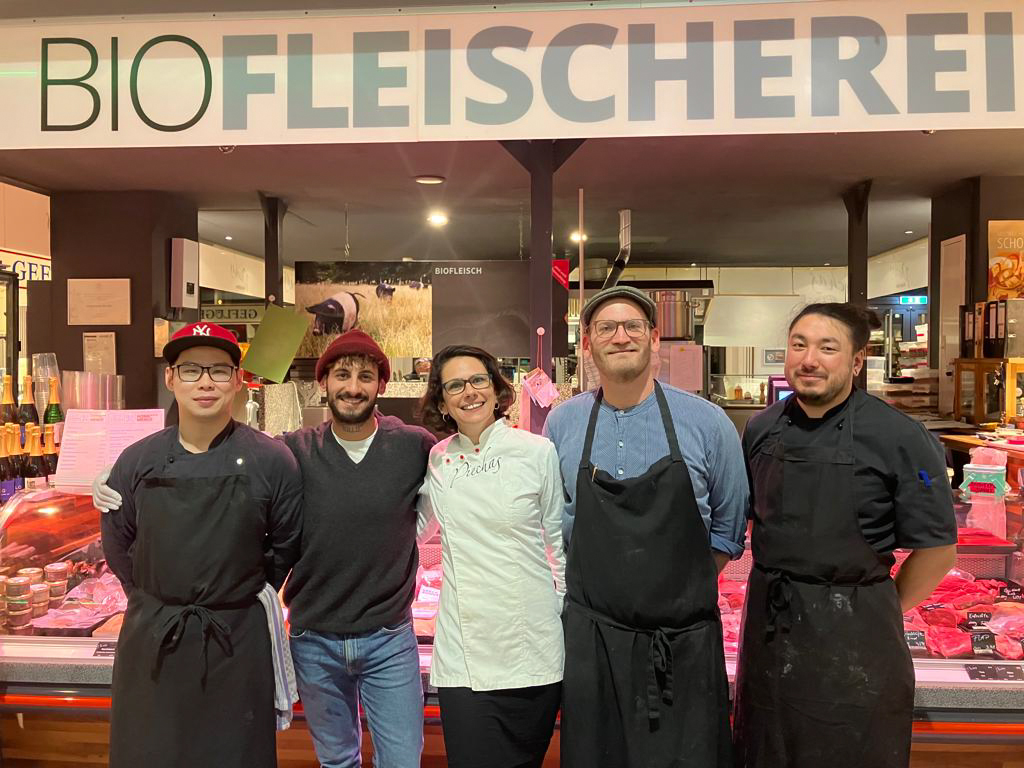
What do you like about the Markthalle, why is it worth a visit, and when is the best time of day to drop by?
The Marheineke market hall has become an indispensable local supplier for the neighborhood. For many of the nearby residents, the hall is their market place, a focal point of daily life for the whole family. The concept of the hall – to guarantee local supply with fresh, regional products with diverse, international offers, and at the same time to provide dining options in restaurant quality at our stalls, and to combine this with basic services, from a newspaper store, a tailor, a cobbler and key service, and an excellent bookstore – has fully succeeded. People in the neighborhood love the hall. It is recommended in Berlin city guides for a relaxing, soothing glimpse into everyday life in Berlin. Here in the hall, as in many market halls in major European cities, urban life can be experienced in all its facets.
With its international traders and offerings, the hall also reflects the development of the Kreuzberg district in recent decades into an international, peaceful neighborhood community.
All the traders in the hall are currently working together to secure the success of the hall for the next 15 to 20 years. I am convinced that we will succeed.
A visit to the hall is of course particularly attractive in the summer, with the flea market around the hall, its outdoor seating, and the children’s playground. But a visit to the Marheineke Markthalle is also a real attraction at any time of the day in winter. All of us traders look forward every day to all our customers and visitors.
Small is Beautiful
There are over 57,000 businesses and just under 300,000 people in Berlin’s smallest borough. While Friedrichshain-Kreuzberg is home to the German HQs of huge companies such as Coca-Cola, BASF, and MTV, one of the many things that make both Friedrichshain and Kreuzberg so good to visit and to live in is the sheer variety and amount of small and independent shops and businesses. Whatever special interest takes your fancy, you’ll probably find a place that caters to it.
A sudden urge to play Dungeons and Dragons? You’ll find the right die or sets for instance in Battlefield Berlin on Gneisenaustrasse. Fancy watching a particular Hong Kong movie from the 1960s but can’t stream it online anywhere? Ask at the famous video store Videodrom, they’ll probably have two versions of it for rent and are so knowledgeable that they can tell you an anecdote about the director’s cat.
We spoke to Videodrom’s owner, known to Berliners and German movie lovers as Graf Haufen.
How do you manage to stay relevant and indeed in business as a video rental store when pretty much all the others have shut down?
Videodrom was always more than a regular video rental store. Since 1984 we’ve been offering original versions (back then VHS tapes available in Germany only featured the German dubbing), experimental and music videos, and films which were not or seldomly found in regular video stores – like arthouse, queer, cinephile or fringe type movies, for example. We continued that concept with DVD and Blu-Ray too. Our goal is to cover the whole history of film – not only Hollywood or easy-to-obtain, well-known European films, but also the more obscure and niche products. One could call our mission to preserve an archive of international film history in all its depth.
We don’t just have all these rare films in stock, also our staff is very knowledgeable and can help out with personal suggestions and recommendations, research and expertise. And that covers highbrow, mainstream, or b-movies.
Customers can find thousands of films here which are not available for streaming and probably never will be. And we also carry a vast selection of films with English subtitles – for those who do not understand German or have use for German subtitles on foreign films.
We also do rental by mail (in a subscription service) in order to supply customers in other cities of Germany.
How many films do you have for rent and what is the most obscure film you have?
Currently we have about 38-39,000 films, series, and documentaries.
To pick the most obscure film is quite impossible, as we have so many rare and under-the-radar type films. One of my personal favorites among the most unusual films is an experimental, monochrome, metaphysical splatter movie called BEGOTTEN. Another favorite is of course THE ROOM by Tommy Wiseau – not as such an obscure film, but a really odd cult film that defies all of the usual criteria of how to make, act in, produce, or direct a film. It's a cult classic in the US, but not very well known in Germany.
Why can a treasured place such as your Videodrom only exist in Berlin?
Well, I think it could also exist in other bigger cities, but the fact that Berlin in the 1980s was a reservoir for crazy, weird, different, queer people with different ideas of how to live their lives, helped in getting a place like Videodrom off the ground. Our customership is multi-national and very diverse. Such an environment obviously helps with an endeavor such as ours.
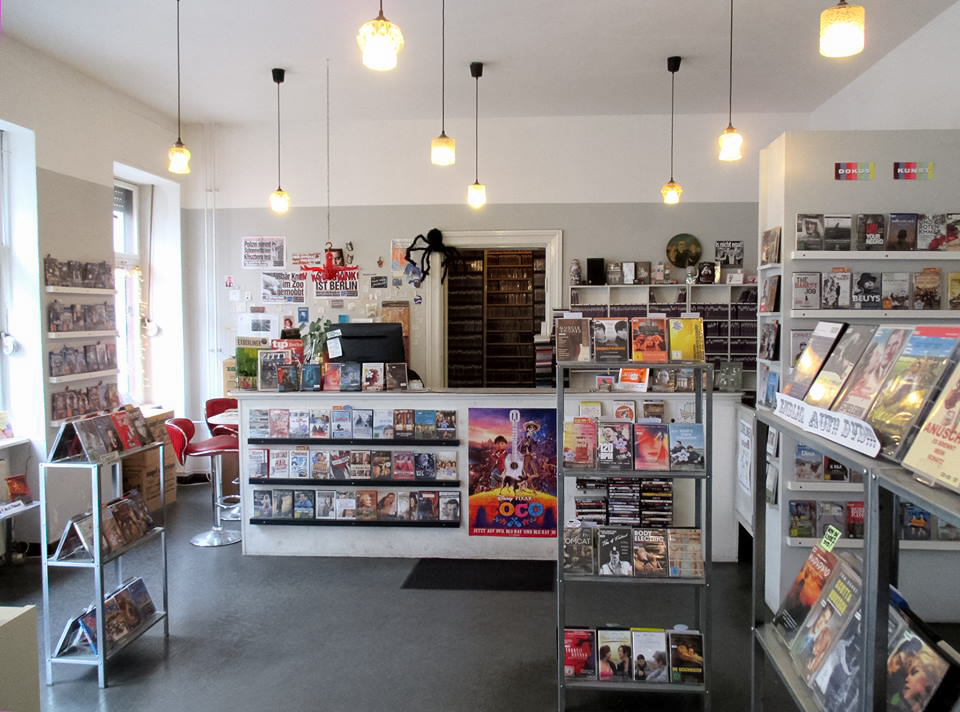
Specialization seems key, and Berlin – in particular Berlin Kreuzberg – is home to enough people with special interests or ways of life to make businesses viable that in other cities would be too niche to make money.
Just down the road from Videodrom are two famous bookstores. These have been successfully asserting themselves against chains and online stores for years, because they are active in highly specific markets and are also experts in their fields.
Otherland is the place to go for science fiction and fantasy books, in English or German. In addition they have a carefully curated selection of English books outside of the genre they are so well-known for among fans of phantastic literature in Germany.
Next to Otherland is the best place to go for murder and mystery. The award winning bookshop Hammett specializes in crime fiction and has a large selection of books in English and German, also second hand. We spoke with owner Christian Koch.
Why is Hammett in Berlin?
That has a lot to do with me. I (usually) like living here in this city. I could not and would not have the Hammett anywhere else. After all, it’s also a piece of Kreuzberg. The shop is over 27 years old and has been here in Kreuzberg the whole time. And where would a bookstore for crime fiction fit better than in Berlin?
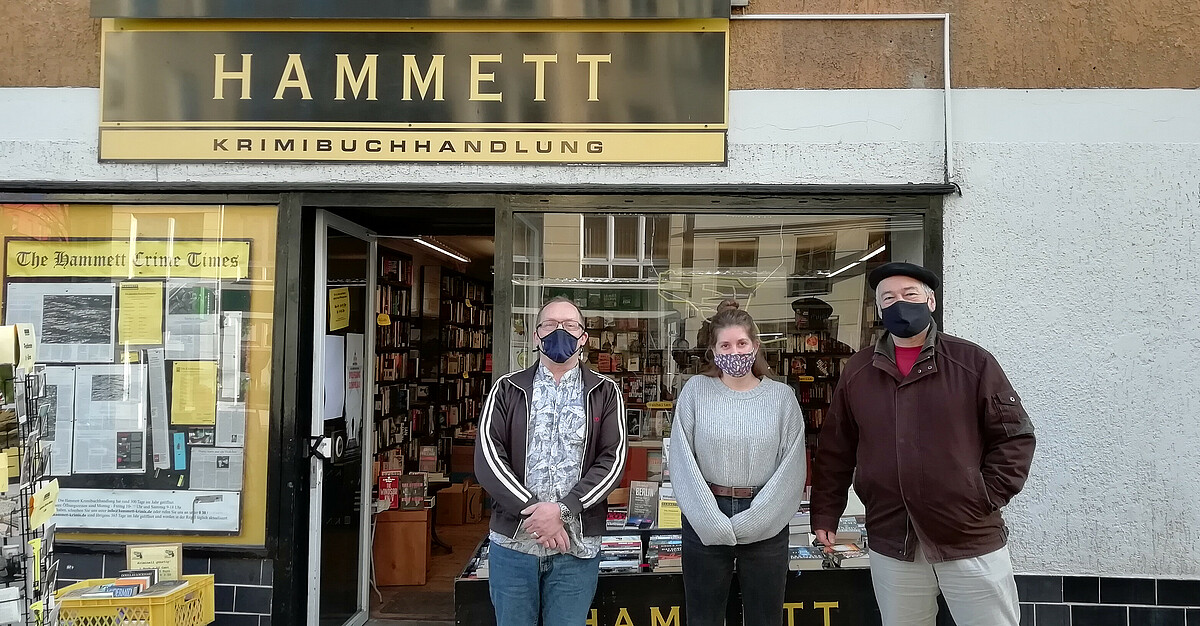
Which is your favorite Berlin crime novel?
“Magic Hoffmann” by Jakob Arjouni and the classic “Berlin Alexanderplatz” by Alfred Döblin.
Why do so many people read crime fiction?
Crime fiction in modern form often depicts a large part of our reality. Moreover, mankind has always been interested in “good” and “evil”. The better crime novels have long been vehicles for social issues and descriptions of people in exceptional situations, often political. This entertains readers and it is basically just exciting!
A Kreuzberg-based storytelling company answers the crime fiction question differently. But while there may be experts on crime in Kreuzberg, the actual crime rate is lower than in heavily touristed areas such as the government district or around Alexanderplatz.
All in all, Friedrichshain-Kreuzberg epitomizes much of what people all over the world associate with Berlin. Mitte may be more central still, but to be in the middle of the hustle and bustle of the real Berlin scene, come to Friedrichshain-Kreuzberg.
Check out our articles on other Berlin boroughs:
- Charlottenburg-Wilmersdorf
- Mitte
- Neukölln
- Prenzlauer Berg and Pankow
- Steglitz-Zehlendorf
- Tempelhof-Schöneberg
Interviews: Olaf Bryan Wielk, ideenmanufaktur
Header image: © Berlin Partner - eventfotografen.berlin

